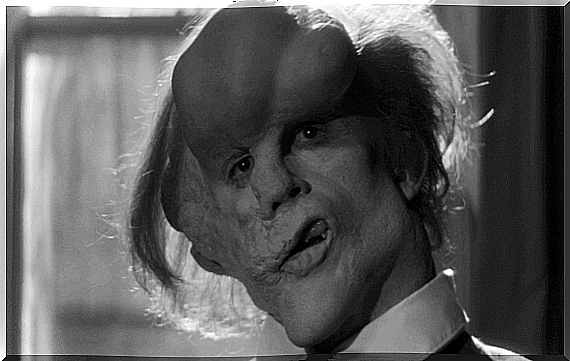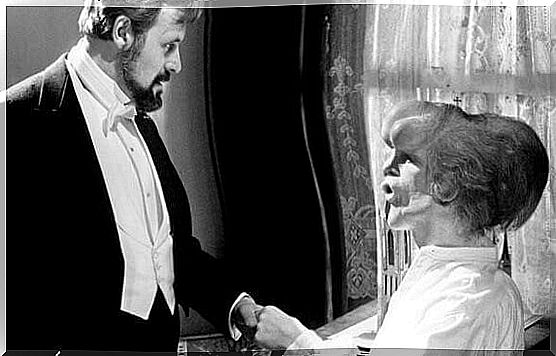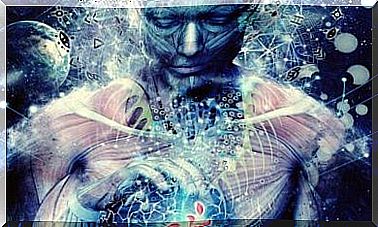The Elephant Man: Reflection On Human Dignity

The Elephant Man is a black and white portrait of human dignity and sensitivity hidden inside a deformed body. In this mythical film by David Lynch we learn the true story of Joseph Merick, a young man suffering from Proteus syndrome who, after spending part of his life in the circus world, finds peace in his last years at the London hospital.
The story tells of the soul of an artist and the heart of a poet of Merrick. He had only one useful hand, and although he was as small as that of a 10-year-old boy, he always showed great skill for manual work. Enough to create fascinating constructions of paper, cardboard and toothpicks. He used to give these small works to all the people who showed themselves kind to him.
When Mel Brooks entrusted David Lynch with the script for this story, he knew very well what he was looking for. Joseph Merrick’s story deserved to be brought to the big screen in a special, different way. It was supposed to be a tribute. The delicacy, virtuosity and intelligence had to stand out on the skin inhabited by bumps and deformities. His humanity had to overcome society, at times contemptible and grotesque, always eager to lay its gaze on what is different and strange.
The result exceeded all expectations. The film was a warm chiaroscuro canvas on human dignity, an unforgettable production where goodness emerges over perversion and monstrosity. The Elephant Man won 8 Oscar nominations in 1981 and although it won none, history has already established it as a cult work, an unforgettable cinematic joy.
The Elephant Man : I’m not an animal, I’m a human being
David Lynch was clear that the elephant man story had to be brought to the screen in black and white. Only in this way was it possible to show the Victorian underworld that accompanied the life of Joseph Merrick. Only in that way would he be able to sink the public’s gaze into that accumulation of anguished sensations that marked the existence of that young British man suffering from serious malformations starting from the first year of life.
Monochromatic photography proved very useful to illuminate the circus underworld where the elephant man was exhibited. The freakshow was the only expedient available to deformed people and Joseph Merrick enjoyed considerable success in Europe during the 1880s. He suffered from what is still considered the most serious case of Proteus syndrome today. He himself described himself as follows:
From the brutal and humiliating circus scenario, we quickly move on to an excited and pitying look that will change the life of Joseph Merrick. He is Dr. Frederick Treves, a role masterfully played by Anthony Hopkins. Able to see the human being under the skin of the “monster”, moved by the cry of a young man who asked to be seen as a person, not as an animal.
The double public performance of The Elephant Man
Although Dr. Treves feels very close to the young Merrick, the viewer always feels that there is also a profound scientific interest in him. He exhibits it in front of eminent pathologists, doctors and surgeons, exhibits it in front of his colleagues and does everything possible to keep the elephant man alive in the London Hospital.
Young Merrick finally manages to show what lies beneath the bumps and thick skin. At first, the scientific community postulated that such a body is certainly the bearer of a serious mental deficiency. However, they will soon discover something that is perfectly documented today. Joseph Merrick was gifted with high intelligence.
He read and wrote with great ease, composed poetry, was a great reader and had an innocent and hopeful worldview. The shadow of his childhood, struck by the jokes, the violence or his dark years in the world of entertainment and the circus had not affected his heart, had not hardened him. As he himself explained, his hope and optimism sprang from love. The love that his mother gave him, a beautiful young woman who passed on to him a passion for books and who died prematurely.

Curiously, and although the London Hospital raised several funds to allow Merrick a comfortable life in the institution and thus avoid the public performance to which he had been subjected, he died on the morning of April 11, 1890, at the age of 27, while he slept.
The young man was a believer and one of his wishes was to be buried next to his mother. However, the scientific interest was not respected or concerned with protecting his dignity. London Medical College’s Pathology Museum exhibited his skeleton for decades. Today his remains are no longer on display (although they are still being studied) and have been replaced with his possessions: his armchair, his manuscripts, the hat with the sewn fabric that covered his face and head …
The elephant man manages to give us a faithful portrait of the humanity contained in the battered body of Joseph Merrick. The music, the photography, the well-studied direction… everything allowed a more than perfect picture full of humanity, where you can discover a mind that has remained intact despite the humiliations and mistreatments.
The elephant man never lost his delicacy, his exquisite manner, his trust in people. Ironically, after his death, he was the victim of another spectacle: that of the scientific world.







